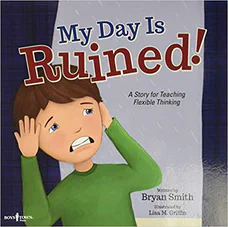My Day Is Ruined!
A Story for Teaching Flexible Thinking

Recommended Age Range: 1st grade through 5th grade.
Publisher's Summary:
Kids who have trouble adjusting to the unexpected and tend to overreact, can learn four steps for achieving flexible thinking in this story…Braden was so excited for his upcoming championship baseball game! …But imagine his surprise when he woke up to pouring rain… But with Mom’s help and the support of a good teacher, Braden learns four steps for flexible thinking, a sure-fire way to meet tough challenges!

Dr. Annie's Takeaways
Recommended for: This story teaches children that they can practice flexible thinking to make it less likely that their days are ruined when something goes wrong (e.g., a rained out baseball game, a fire drill during freetime). It’s an empowering message, and it’s provided by a relatable protagonist. Kids whose days are easily ruined by small setbacks will likely feel understood by Braden and comforted by the idea that they might not need things to go perfectly in order to feel okay.
Would a child like it? Many children will relate to Braden and feel validated by his observations and grievances. It’s not the most artful or engaging story, but it teaches an empowering skill.
Tone: Instructive, encouraging, a bit funny
Story Quality: It’s not the most engaging story, but it’s decently well-written and useful enough that I’m including it on the Bookshelf. Braden is a fairly real-seeming character, and he says relatable things like, “How many of you out there just hate it when someone ruins your day and then acts like YOU’RE the one who’s wrong.” It does a nice job of meeting children where they’re at, and it’s not-at-all mean or judgmental of Braden’s reactions. This is very important because kids reading this book are likely to have had experiences of being judged for their reactions and are likely to be sensitized to implications that they’re the problem. The story is a bit long and might be tough for some younger or more inattentive kids to sit through.
Illustrations: Digital illustrations that are fine and inoffensive but nothing too special.
Representation: Braden is an 8-year-old White boy with a White mother and little brother. He has a White female teacher, Mrs. Vickerman. Two of Braden’s classmates are briefly pictured–a White boy and a Black girl.
Psychological Practices: This story introduces the important, empowering idea that flexible thinking can make a child’s feelings less dependent on factors outside of their control. Many children who struggle with flexible thinking are afraid of things going wrong, and they can become a bit rigid or controlling in an attempt to prevent their days from being ruined. This book teaches children that they can change how they think about a situation when something goes wrong, and that this will change the impact that this setback has on them. The story teaches a four-step method to flexible thinking that is okay as an introduction but isn’t quite specific enough to be super helpful. The steps are: “1) Take a deep breath. 2) Realize some things are out of your control. 3) Change your plan. 4) Accept the change.” It provides several useful examples of Braden using this method to cope with setbacks (e.g., a preferred lunch item not being available), and it effectively shows how much better the outcome is for Braden when he uses his flexible thinking.
Concerns: My primary concern is that the steps provided aren’t specific enough. Many children struggle to come up with alternative plans, and accepting a change is much easier said than done. They’re a good start, though, and with some adult scaffolding (e.g., support with problem solving to come up with new plans), these steps will likely be helpful.
